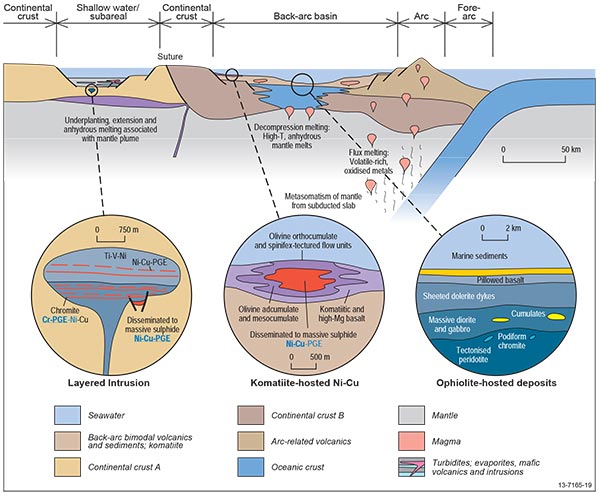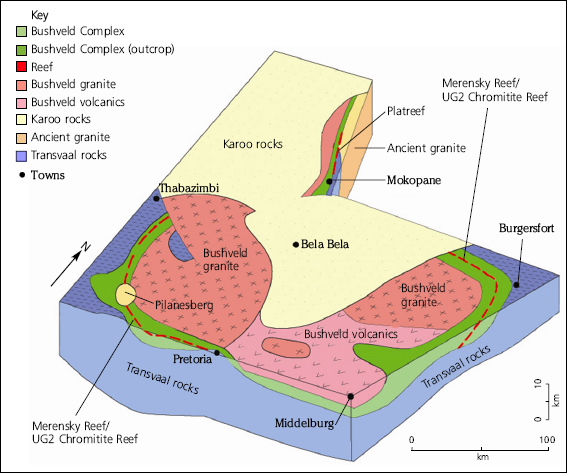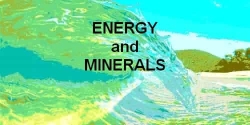Magmatic Deposits / Prospecting Guidelines
Magmatic Deposits / Prospecting Guidelines
Abridged and adapted to HTML from Notes From The Prospecting School on the Web By Luca Riccio for the B.C. & Yukon Chamber of Mine
Magmatic Base Metal Deposits
1.Chromite Deposits
2.Nickel-Copper Deposits
3.Platinum Group Metals PGM
Exploration (Prospecting) Guidelines
1.Exploartion for Chromite
deposits
2.Exploration for Nickel-copper
deposits
3.Exploration for Platinum deposits

Magmatic sulfide deposits fall into two major groups when considered on the basis of the value of their contained metals, one group in which Ni, and, to a lesser extent, Cu, are the most valuable products and a second in which the PGE are the most important.
The first group includes komatiite- (both Archean and Paleoproterozoic), flood basalt-, ferropicrite-, and anorthosite complex-related deposits, a miscellaneous group related to high Mg basalts, Sudbury, which is the only example related to a meteorite impact melt, and a group of hitherto uneconomic deposits related to Ural-Alaskan–type intrusions.Most Ni-rich deposits occur in rocks ranging from the Late Archean to the Mesozoic
PGE deposits are mostly related to large intrusions comprising both an early MgO- and SiO2-rich magma and a later Al2O3-rich, tholeiitic magma, although several other intrusive types contain PGE in lesser, mostly uneconomic quantities.
PGE deposits tend to predominate in Late Archean to Paleoproterozoic intrusions, although the limited number of occurrences casts doubt on the statistical validity of this observation.
A number of key events mark the development of a magmatic sulfide deposit, partial melting of the mantle, ascent into the crust, development of sulfide immisciblity as a result of crustal interaction, ascent of magma + sulfides to higher crustal levels, concentration of the sulfides, their enrichment through interaction with fresh magma (not always the case), cooling and crystallization.
Factors governing this development include
- the solubility of sulfur in silicate melts and how this varies as a function of partial mantle melting and subsequent fractional crystallization,
- the partitioning of chalcophile metals between sulfide and silicate liquids, and how the results of this vary during mantle melting and subsequent crystallization and sulfide immiscibility (degree of melting and crystallization, R factor and subsequent enrichment),
- how effectively the sulfides become concentrated and the factors controlling this, and
- processes that occur during the cooling of the sulfide liquid that govern aspects of exploration and mineral beneficiation.
Base Metals
Magmatic Base Metals DepositsChrome - Nickel/Copper - Platinum Group Metals (PGM)
Magmatic Deposits are so named because they are genetically linked with the evolution of magmas emplaced into the crust (either continental or oceanic) and are spatially found within rock types derived from the crystallization of such magmas. The most important magmatic deposits are restricted to mafia and ultramafic rocks which represent the crystallization products of basaltic or ultramafic liquids. These deposit types include:

1.Chromite Deposits
Chromite deposits are the end product of the separation of solid phases (Cr-rich spinets, (Fe, Mg) (Al, Cr. Fe) 2O4) from a liquid and their accumulation into chromite-rich layers. The processes involved in the formation of chromite layers are fractional crystallization and gravity settling. Chromite crystallizes into mineral grains within the silicate liquid and, because they are heavier than the liquid, they sink to form a cummulate layer at the base of the intrusive.
There are two main types of chromite deposits:
- Stratiform and
- Podiform.
2. Ni-Cu+/-Co Deposits
Ni-Cu Deposits are the end of a magmatic process known as "liquid immiscibility''. This process involves the separation from the parental magma of a sulphur-rich liquid containing Fe-Ni-Cu. Upon cooling, the sulphur-rich liquid produces an immiscible sulphide phase (droplets of sulphide liquid in silicate liquid, like oil in water) from which minerals such as pyrrhotite (FeS), pentlandite (Fe,Ni)9S8, and chalcopyrite (CuFeS2) crystalize. Typical magmatic Ni-Cu deposits tend to occur in embayments at or near the base of their intrusive hosts.They occur at the base of the intrusives because
- immiscible sulphide liquids are heavier than silicate liquids and therefore sink to the bottom of the magma chamber and
- b) without the presence of sulphur, metals such as Ni become incorporated into silicate crystal structures, such as pyroxene. Ni-Cu deposits are found in layered intrusions, stocks and ultramafic sills and flows. The largest deposits are of Archean and Proterozoic age.

3. PGM Deposits
Platinum Group Metals (Platinum, Pt; Palladium, Pd; Iridium, Ir; Rhodium, Rh; Osmium, Os; and Ruthenium, Ru) have genetic affinities to both Ni-Cu-sulphides and chromites. However, while the fundamental processes involved in the formation of Ni-Cu and chromite deposits are relatively simple, the concentration and deposition of PGM appears to be a not too well understood, diverse sud multistage process.Several lines of evidence indicate that PGM can
- concentrate during high-temperature deposition of chromites,
- be incorporated into immiscible liquids,
- be remobilized and reconcentrated during metasomatic and hydrothermal activity.
- The Merenski Reef of the Bushveld Complex in South Africa,
- .The Ni-Cu deposits of the Noril'sk-Talnakh District in the U.S.S.R.,
- By-product of several Ni-Cu deposits (Sudbury, etc.),
- Placers derived from zoned (Alaskan-type) uyltramafic intrusions (Columbia, Goodnews Bay, Tulameen),
- .Metasomatic dunite pipes of the Bushveld Complex. The bulk of present world production comes from the Bushveld and Russian deposits and most presently known reserves are within Merenski-type environments (Bushveld and Stillwater Complexes).
They occur at or near the base of complexely differentiated gabbro-dolerite intrusions (50 to 350 m thick) emplaced during late Permian to Triassic time during rifting of the Siberian platform. The sills are considered to be feeders to overlying plateau basalts.
The mineralogy of the ores include pyrrhotite, chalcopyrite, pentlandite and a great variety of PGM minerals. Placers derived fromAlaskan-type intrusions are the results of the breakdown, transport and concentration of Pt-Fe alloys mainly associated with Fe-rich chromite layers from the dunitic portions of thse complexes.
The metasomatic dunite pipes of the Bushveld Complex played a significant role as high-grade platinum producers during the early days of platinum mining in South Africa. They consist of central zones of Fe-rich dunite enveloped by shells of dunite and pyroxenite.
The pipes which transect at right angles the critical zone of the complex, are 20 to 200 m in diameter and contain axially located pay zones with surface dimensions not exceeding 20x25 m. The ores are pegmatitic and may contain slabs of chromitite. Spot assays as high as 1,990 grams per tonne Pt. were recorded from dunite pipes.
Before concluding this brief summary on PGM deposits, it should be stressed that most disseminated sulphide zones carrying appreciable PGM values are characterized by:
- Pegmatitic textures
- the presence of hydrous minerals within otherwise anhydrous layered successions. These features,which point to high fluid activity during magmatic segregation, are important prospecting guides.
Exploration (Prospecting) Guidelines
Chromite Deposits
Stratiform: 1.Identify well layered mafic-ultramafic intrusions;
2.Prospect below the mafic cumulate portions of the intrusions (i.e. below the portion which is completely gabbroic).;Podiform:& 1.Carefully prospect within all dunitic portions of Alpine-type peridotites (Harzburgite-Dunite components of ophiolite complexes).
Ni-Cu Deposits
1.Prospect in the lowermost portion of layered and not so well layered mefic-ultramafic intrusions (both cratonic and synorogenic), komatiitic flows and sills;2.Pay special attention to embayments in basal contacts.
PGM Deposit
1.Identify layered mafic-ultramafic intrusions and differentiated sills (possibly cratonic);2.Sample any sulphide-bearing material, especially if carrying visible pyrrhotite-chalcopyrite mineralization;
3.If prospecting for Merenski-type occurrences, look for very thin (1 m) but laterally persistent disseminated sulphide-bearing horizons within complexly interlayered peridotite-pyroxenite-troctolite-anorthosite and gabbro sequences;
4.Look for sulphide-bearing material near contact zones of mafic-ultramafic complexes composed of several intrusive phases;
5.Look for unusual textures and mineralogy. Namely look for pegmatitic textures and development of hydrous minerals within layers or massive units that are normally of even grain size and anhydrous;
6.Investigate the drainage of Alaskan-type intrustions for potentially significant Pt placers.

